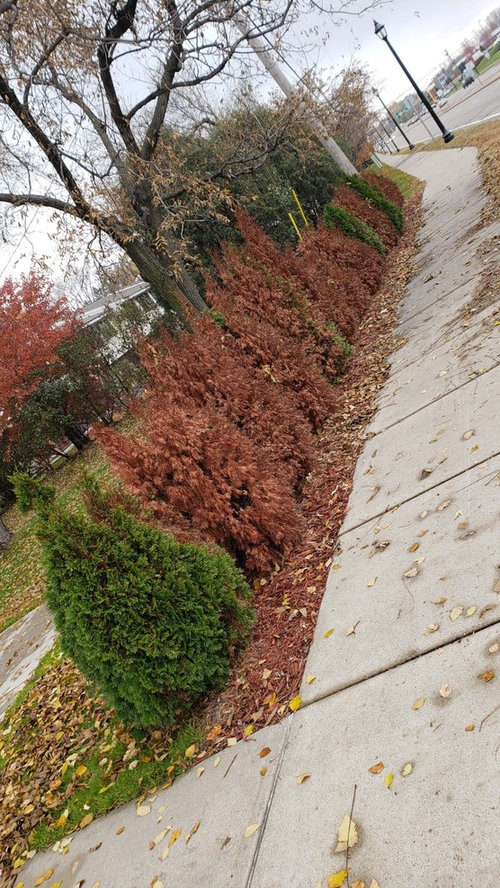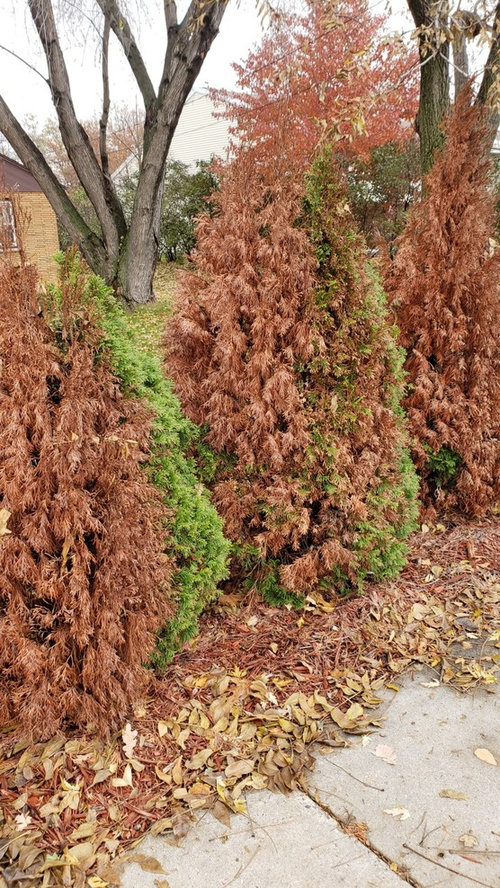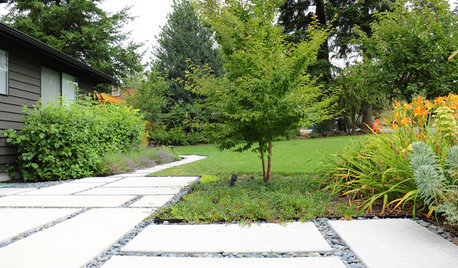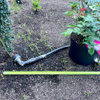Arborvitae Heartbreak :(
So I planted 15 small emerald green arborvitae about 4 years ago and after not doing so well their first winter they've been pretty solid however I feel like they should be taller than they should be as I'd say they've probably only doubled in size. We planted these to create a privacy hedge along a sidewalk and road. Well last Fall we thought that they had been established enough that we decided to not wrap them in burlap for winter and well this spring they all suffered great winter burn. Not sure if it was just the winter we had or we simply are just going to have to wrap these every year. At the beginning of spring they were all burnt and looking dead but Luckily I was able to get about half of them to come about half back and now I'm wondering if I should prune out what appears to be dead or wait until next Spring? Also I'm assuming the others are dead, do I wait until next Spring to pull them out? If most of the tree is dead but there is indeed some new green on it do I give it the tree a chance? Also should I simply plan on having to wrap these trees every winter for as long as I live here or do you think snow fence on the side of the road is enough as I believe salt off the road may be part of the problem too...
Also anything I can do to get these things growing better or did I just not do enough appropriate prep work when planting them? We have heavy clay soil!


Comments (30)
cearbhaill (zone 6b Eastern Kentucky)
5 years agolast modified: 5 years agoSome location/zone information would be quite helpful.
Most arborvitae failures can be tracked back to poor planting and watering during the establishment phase. The roots must be opened up during planting and the watering must be slow enough and long enough to penetrate deeply enough. Often these are mass produced and sold in poor condition planted in water repellent peat and it can be tricky to get the water to actually penetrate the root ball unless you have opened it up and take the time to see that enough water gets to where it needs to be. Once established they are easier.
Without zone/location info it's impossible to speculate about winter practices but if you are in a location where they are unsuited there are plenty of other conifers to choose from.
Jess Barrett thanked cearbhaill (zone 6b Eastern Kentucky)Jess Barrett
Original Author5 years agoThanks cearbhaill thanks for the followup. Are you saying that once the plants are established that they can recover from crappier planting practices? Like I mentioned these have done great for the last 3 years other than some of them not getting a ton taller. I'm in zone 4b Minnesota and the trees are on the west side of the our property. Thanks again
Related Professionals
Sahuarita Landscape Architects & Landscape Designers · Deerfield Landscape Contractors · Fishers Landscape Contractors · North Highlands Landscape Contractors · Chicago Ridge Landscape Contractors · Forest Hill Landscape Contractors · Tomball Decks, Patios & Outdoor Enclosures · Woodinville Landscape Architects & Landscape Designers · Brooklyn Park Landscape Contractors · Coram Landscape Contractors · Holtsville Landscape Contractors · Mesa Landscape Contractors · Milford Landscape Contractors · Brenham Driveway Installation & Maintenance · Anaheim Driveway Installation & Maintenancemaackia
5 years agoI won't speculate on the cause, but I did see a lot of similar damage to arborvitae this spring. I'm not sure what it was about this past winter that caused it, but it was very prevalent. I saw well-established arbs that looked similar to what you have. It was especially noticeable in southern Minnesota. The upper Midwest had an unusually difficult April that may have contributed to their demise. Here's a short article from the MN DNR about this situation.
Jess Barrett thanked maackiaschoolhouse_gw
5 years agoNo advice except what has been given, but want to say how sorry this happened to your arborvitae. As you say, it is such a disappointment. I noticed up the road someone planted a border of small arb. and they were doing well. Then they decided to plant bigger specimens behind the smaller ones I guess to double the windbreak or privacy. Those bigger ones did not fare as well - mostly all rusted like yours.
Jess Barrett thanked schoolhouse_gwken_adrian Adrian MI cold Z5
5 years agoI'm in zone 4b Minnesota and the trees are on the west side of the our property.
==>>>so the sidewalk gets afternoon sun????
im wondering about winter sun heating the cement sidewalks ... especially in relative mid winter heat waves ... causing tissue to thaw and refreeze repeatedly during winter ... leading to freeze drying of tissue ....
road salt would be a second issue ... of which i have no comment ...
kenJess Barrett thanked ken_adrian Adrian MI cold Z5ken_adrian Adrian MI cold Z5
5 years agoor did I just not do enough appropriate prep work when planting them? We have heavy clay soil!
==>>> does your soil perk??? ..... https://duckduckgo.com/?q=garden+soil+perk+test&t=ffcm&ia=web
how did you plant them???
were they potted ... if so.. what did you do to the root mass ... was there significant root circling????
kenJess Barrett thanked ken_adrian Adrian MI cold Z5Jess Barrett
Original Author5 years agoThanks everyone for your Reponses…if
I’m honest this has been a very devastating thing for me knowing the time and $
I’ve put into these trees only to lose over half of them due to not wrapping
them one winter ☹maackia thanks for the info on the MN
DNR’s page as I thought I had noticed other people’s arbs/evergreens burnt too
and yes we did have a rollercoaster of an April. I’m assuming that pruning the
bad out of the trees now is a bad idea? Also I’m thinking of just putting up a
wood slat snow fence on the sidewalk (west side) this year instead of wrapping
them, is that an okay approach?As far as the “soil perking” I
have no idea I’ve never even heard of that until you mentioned it. Is there any
sense on doing the test now, can it wait until spring? Same thing with your “root
circling” question as I have no idea what that is either? When we purchased
them they were potted yes and as far as the root ball we just “unballed” them
some before putting them in the hole while adding potting soil. I'll be the first to admit that I know very little about planting, etc. :(pennlake
5 years agolast modified: 5 years agoUnfortunately not the best choice in arborvitae for Minnesota. In fact, the state of MN list the hardiness as zone 5. Most commonly sold at big box stores around here. In our test block some Arbs we’re fine and others were toasted after this past winter. I don’t know if wrapping them would have helped or not.
Jess Barrett thanked pennlakesaradanvac
5 years agoThis was super common in northern MN this year. Guessing you had the same experience. Here's a link about it
https://www.google.com/amp/www.duluthnewstribune.com/news/science-and-nature/4466004-dry-windy-april-killed-conifers-northland?ampJess Barrett thanked saradanvacEmbothrium
5 years agolast modified: 5 years agoI'm in a cool summer part of USDA 8 and it seems a majority of 'Smaragd' hedges here in my area - a locale where there are a great number of them - has a percentage of partly or completely dead individual specimens. Based on the timing I suspect the more pronounced summer conditions we have been having in recent years is involved. All the more so because some years ago I happened to notice a long established planting was turning dull looking due to an obvious (once I got close enough) mite infestation.
Otherwise there's an Oregon State University web page that says this cultivar is more prone to root rot than usual for Thuja occidentalis forms.
Jess Barrett thanked EmbothriumJess Barrett
Original Author5 years agoThanks everyone for the reassurance that losing these trees wasn't necessarily all my fault and maybe I would have lost some even if I had wrapped them. So again if anyone has any advice in terms of wrapping them or doing a snow fence this year which would you choose. Also even I do wrap them should I still wrap the ones that only have green on less then a 1/4 of the tree? And would you even bother wrapping any of them that don't have any green on them? Thanks again everyone!
OldDutch (Zone 4 MN)
5 years agoThose that never greened up at all this summer are almost certainly completely dead. Many of those with only a little green are mostly dead. Much of the dead even if cut out will leave the surviving part mishappened on any one with significant burn that has not greened up by this time. Sorry but most of those damaged plants should probably be replaced.
Jess Barrett
Original Author5 years agoWell since I'm assuming I'm going to have to pull these out and replace them with something else, as I'm thinking it's not cost effective to replace just the dead ones. If I'm to start fresh on this privacy hedge, what would you all recommend I plant then? Thanks!
Ugh it still breaks my heart that he money and time I lost on these arbs.... :(Mike McGarvey
5 years agoDid you give them additional water during the summer? It looks like they dried out to me. The classic signs are there. When you dig them up, take a look at the rootballs to see if the roots ever spread out from the original rootballs.
Jess Barrett thanked Mike McGarveyOldDutch (Zone 4 MN)
5 years agoThis is classic winterburn, that many arbor vitae and a whole lot of other special and miniature or smaller sized conifer varieties are subject to regardless of how well watered they were during the summer. Wrapping is about the only sure fire protection, and burlap is probably the cheapest while still being effective. You will notice that one side survives on many of them, and that is the protected side.
Jess Barrett thanked OldDutch (Zone 4 MN)pennlake
5 years agolast modified: 5 years agoA deciduous shrub might be better for that location if you are okay with that. Otherwise Arborvitae is a decent choice among evergreens, just select one recommended for MN
gardengal48 (PNW Z8/9)
5 years agoWinter burn in a plant that is native to the upper midwest? That seems highly unlikely, especially with 'Smaragd', which is known for being quite resistant and maintaining its deep, rich, green color all winter....even in very cold climates (fully hardy to zone 3). Nor are the symptoms consistant with winter burn.
It is far more likely that issues during establishment have shown up in a delayed (aka tree-time) fashion. Both too dry conditions and too wet conditions can result in dieback like is shown. And an inadequate or compromised root system (circling or girdling roots) can also result in serious dieback and death.
FWIW, winter burn is never an issue in my climate and yet one can see arbs that demonstrate nearly identical symptoms of decline and failure often. Due entirely to the conditions listed above.
littlebug zone 5 Missouri
5 years agoI see larger well-established trees nearby. I think your arbs dried out due to the combination of root competition and the lack of water all last year. Here in north Missouri we had a terrible drought in 2018 (which didn’t let up till last month - please make it stop snowing!!) and I lost several things.
OldDutch (Zone 4 MN)
5 years agolast modified: 5 years agoOld fashioned arbor vitae like pyramid and Techny seldom winter burn, and the original wild types are definitely native but also generally sheltered from drying winter winds, being bottom or swamp types. Developed types however are often far more susceptible especially those with reduced size, and that is a general issue with almost all reduced size evergreens except the crawling junipers.
The key here is simple this is the first winter they were not wrapped. These have been in place for 4 years, planting and/or watering issues would have shown up before this. Seasonal drought would have shown up by autumn and would not have been concentrated on one side which is obviously the windward side. Those with some green have it where sheltered.
From years as a landscaper and a state inspected nurseryman, I say winter burn, and sorry it was the lack of burlap that winter.
I also say that any kind of hedge is going to have occasional loss and need to have replacement plantings from time to time. Actually arbor vitae is a good choice for what is wanted but one needs to research varieties against repeat of winterburn. They are not all the same. Also the undeveloped wild type will simply be too larger for this application. Back in the day I would have recommended the old fashioned pyramidal variety, but what is currently available I do not know. It has been some time since I worked landscaping.
pennlake
5 years agoSorry but no.....despite being native to the NE part of MN of the state not all Thuja occidentalis selections are suited to this climate. Especially as they get pushed west and southwest into the prairies. A selection suited to this climate does not need to be wrapped.
dandy_line (Z3b N Cent Mn)
5 years agoThe warnings about arborvitae in Mn have been out there for at least a century now. Too bad you didn't do some research ahead of time. I understand your need for a privacy hedge as that was my first priority fifty years ago too, but mine was in a different climate. But those you have cannot be saved so plan on ripping them all out.
Deciduous shrubs are the only thing that makes sense and as was pointed out, the Mn Arboretum has lots of species to help sort things out.
Me-I would plant Lilacs, which are like indestructible, and have phenomenal fragrant flowers. Unfortunately they are not native(but they've been here for so long it seems like they are).
Or, native flowering/fruiting kinds for wildlife would be Chokeberry, Dogwood, Viburnum, Elderberry backed up with some flowering plum/crabapple etc etc. Turn your entire property into a wildlife sanctuary. Now that would make more sense.
Watch this video about turning urban landscape into a nature habitat.
Jess Barrett
Original Author5 years agoThanks everyone, I guess you can't trust the folks at Home Depot when they said they'd work great for my needs....I guess a trip to the arboretum is in order then.
OldDutch (Zone 4 MN)
5 years agolast modified: 5 years agoThat is as good a place as there is to do your research. The staff there has no axe to grind nor any sales quota to meet, either.
Northern Gardener (3b west central MN)
5 years agolast modified: 5 years agoIf your space isn't too restricted (and it looks like there's plenty), I'd recommend a diversified planting of deciduous shrubs that are amenable to pruning for shape and rejuvenation, so that if you lose something or it doesn't do well, it won't look too weird to replace it with something else. And stagger the planting so it's not all in a straight line; you'll get your screen sooner that way, while still allowing space for your selections to grow healthily. Be prepared to enjoy learning about the habits and needs of your shrubs.
Personal experience: I've made a privacy screen of various shrubs, some green, some purple-leaved, blooming at different times of year, along part of my lakeshore so I can sit in my back yard and not have to wave at (gotta be polite at least, a lot of these people are acquaintances who mean no ill) or be stared at by every boatload of gawkers out for a cruise of their neighbors' back yards. While I'm happy to invite all and sundry to come and visit the gardens, I prefer to actually issue the invitation myself; so privacy is a primary goal. The shrub border also gives wind shelter to my plantings and pots, especially things like begonias and fuchsias, which hate wind.
Besides the obvious maintenance during establishment (seems like the average time period is about three years), choosing shrubs with similar light/water/soil preferences plus allowing adequate spacing and being patient for the shrubs to fill in, is key. Dream, imagine, walk through nurseries, go to the Arb and check out possibilities. Good luck!
P.S. Not a fan of the common lilac in the usual city yard: they really want to be 12 ft tall, get leggy, can become thin on the bottom, and are invasive. Great for shelter belts! Not maybe so much for the urban landscape except as well-maintained specimens. Be prepared for considerable maintenance if using as a privacy hedge. "Miss Kim" (which is not a syringa vulgaris) being a possible exception.chikagostyle
5 years agoI believe salt can burn the trees. since you didn't protect them from the salt spray of the roads and sidewalks maybe that caused this? I have a neighbor who had the same problem from salt
farmboy1
5 years agoI am working temporarily at a Menards store in the Garden Center. We get a large shipment of 5-6' tall arborvitae (from the Pacific Northwest) for a special sale every year. The arbs are initially planted in clay soil, then dug out and stuffed into a plastic pot about a foot in diameter. The pot is rarely bigger in diameter than the foliage, so not much rainwater will reach the roots. Watering them really does not get much water into the rootball before the pot starts to overflow. This happens with regular arbs, too. So it's easy to see how the trees can be weak to start with. Road salt or a colder than normal winter will affect them easier/more than other plants. Good luck!
FrozeBudd_z3/4
5 years agolast modified: 5 years agoFarmboy1, a local greenhouse always brings in such field grown arborvitae that have been dug and stuffed into small pots. These specimens have seriously compromised root systems and plants often start to dry and die right in the nursery lot. I only purchase those that have been container grown with their roots fully intact. Like most potted specimens, they might then be somewhat rootbound and require a bit of tickling apart, though good success is had with them
OldDutch (Zone 4 MN)
5 years agoField grown nursery stock has always been transplanted and root pruned several times; so the small pots are not necessarily improper. Second owner care at the retail or wholesale nursery that does not keep the smaller containers watered properly often accounts for more loss than the initial growing and potting on. Always survey all the offering at an outlet and only buy from those that keep their stock well cared for. Overlooked displays and dried out or under-fertilized offerings are an important signal to buy elsewhere. Same for woody plants and for garden vegetables. Whether stock in bad condition is the fault of the grower or the retailer is at that point pretty much irrelevant.
Jess Barrett
Original Author5 years agoThanks for the followup everyone, I'm pretty sure it was indeed winterburn that killed my trees. I guess I assumed arborvitae would be a good choice as I feel like I see them all over MN. I'm not sure when I'll have a chance to make it to the arboretum any time soon so if anyone has any specific plants/shrubs to try or that you think that would see fit that would be awesome. As far as lilac, the fragrance actually gives me a headache so I think I'll steer away from them, but thanks for the suggestions.










OldDutch (Zone 4 MN)